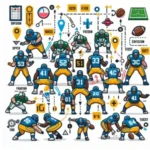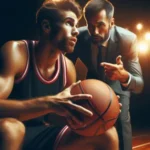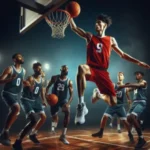In the world of basketball, the adage “defense wins games” resonates deeply among players and coaches alike.
While flashy dunks and three-point shots often steal the spotlight, it’s the unsung heroes on the court—the defenders—who lay the foundation for a team’s success. Mastering the art of defense is crucial for anyone looking to elevate their game, whether you’re a seasoned player or just starting out. This blog post will delve into the essential keys to becoming a stellar basketball defender, exploring techniques that enhance your agility, anticipation, and overall defensive IQ. From proper positioning and footwork to effective communication and mental resilience, we’ll uncover the strategies that can transform you from a passive player into a defensive powerhouse. Join us as we break down the pivotal elements of defensive play that not only disrupt opponents but also invigorate your team’s performance on the court.
1. Understanding the Role of a Defender in Basketball
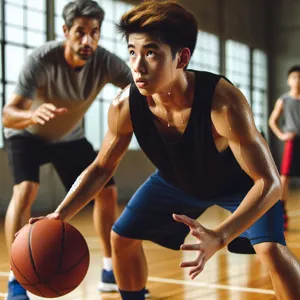
Understanding the role of a defender in basketball is crucial for any player aiming to elevate their game. Unlike the glitz and glamour often associated with scoring points, defensive prowess is the backbone of a successful team. A defender doesn’t just aim to stop the opposing player; they must anticipate their movements, read their intentions, and respond with agility and intelligence.
At its core, the role of a defender involves three key components: positioning, communication, and discipline. Effective positioning is essential; a defender must always be between their opponent and the basket, utilizing their body to create a barrier while also staying low and balanced to react quickly. This means mastering the art of footwork—being able to slide in front of an attacker or pivot to stay in front of them without fouling.
Communication is equally vital. A great defender isn’t just focused on their own matchup; they must work as part of a cohesive unit. This entails calling out screens, alerting teammates of potential switches, and maintaining a collective awareness of offensive threats. A well-organized defense can often disrupt the opponent’s rhythm, leading to turnovers and missed shots.
Lastly, discipline cannot be overstated. A stellar defender knows when to apply pressure and when to retreat, balancing aggression with caution. This involves not biting on fakes, avoiding unnecessary fouls, and sustaining focus throughout the game.
Understanding these facets of defense transforms a player’s approach to the game, creating a solid foundation for becoming an indispensable asset on the court. By honing these skills, players not only improve their individual performance but also contribute significantly to their team’s overall success, proving that indeed, defense wins games.
2. The Mindset of a Stellar Defender
When it comes to becoming a stellar basketball defender, the right mindset is just as crucial as physical skill and technique. A defender’s mentality is characterized by relentless determination, focus, and the unwavering belief that every possession matters. Great defenders approach the game with an aggressive yet calculated attitude—always ready to anticipate their opponent’s moves while maintaining a disciplined stance.
Firstly, confidence plays a pivotal role in a defender’s effectiveness. A stellar defender exudes self-assurance, believing in their ability to disrupt the offensive flow. This confidence helps them stay composed in high-pressure situations, allowing them to make quick decisions and react instinctively. It also sends a message to their opponents: they’re not just there to fill a role; they’re a formidable barrier standing between the ball and the basket.
Moreover, a strong work ethic is a hallmark of the defensive mindset. Stellar defenders understand that practice isn’t just about sharpening their shooting or dribbling skills; it’s about honing their defensive prowess. They commit to rigorous drills that enhance their footwork, lateral quickness, and reaction time. This dedication to improvement translates into on-court performance, making them formidable when protecting the rim.
Equally important is the willingness to learn from mistakes. Every great defender has been beaten at some point, but what sets them apart is their ability to analyze those moments, adapt, and come back stronger. They embrace feedback and actively seek constructive criticism, using it as a tool for growth. This resilience is what fosters a continuous cycle of improvement, ensuring they remain a dynamic force on the court.
Lastly, a stellar defender possesses an unwavering sense of teamwork. They know that defense is not just an individual pursuit but a collective effort. Great defenders communicate effectively with their teammates, providing guidance and support while remaining aware of their surroundings. They understand defensive rotations, help-side responsibilities, and how to leverage their teammates’ strengths to create a unified defensive front.
In summary, the mindset of a stellar defender encompasses confidence, a strong work ethic, a willingness to learn, and a commitment to teamwork. By cultivating these traits, aspiring defenders can elevate their game and become essential players on their team, proving that defense truly wins games.
3. Essential Defensive Stances and Footwork
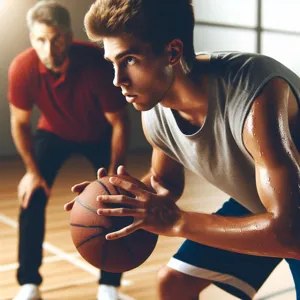
Mastering essential defensive stances and footwork is crucial for any player aspiring to become a stellar basketball defender. The foundation of effective defense lies in your ability to maintain balance, agility, and readiness. A proper defensive stance is the first step; it allows you to react swiftly to your opponent’s movements. Bend your knees slightly, keeping your feet shoulder-width apart for stability. Your weight should be distributed evenly, allowing for quick lateral movements.
As you position yourself, keep your hands active and ready, either extended to disrupt passing lanes or close to your body to protect against drives. Your head should be up, enabling you to keep an eye on both your opponent and the ball, ensuring you’re always aware of your surroundings.
Footwork is where the magic happens. Practicing lateral slides will enhance your ability to stay in front of your opponent, making it harder for them to get past you. Remember to push off from your back foot as you slide, ensuring you maintain a low center of gravity. Drills that involve shuffling, closing out on shooters, and backpedaling will further refine your footwork, allowing you to transition seamlessly between different defensive situations.
Moreover, understanding how to pivot effectively can give you the upper hand when guarding an agile player. Incorporate quick pivots into your training regimen to improve your reaction time when an opponent tries to shake you off their path.
Incorporating these essential stances and footwork techniques into your practice routine will not only enhance your defensive skills but will also build your confidence on the court. A strong defensive presence can turn the tide of a game, and with dedication to mastering these fundamental elements, you’ll be well on your way to becoming a formidable defender.
4. Key Defensive Techniques: One-on-One Defense
Mastering one-on-one defense is a crucial skill for any basketball player aiming to excel on the court. This technique requires a combination of agility, discipline, and strategic thinking. When you’re matched up against an opponent, the primary goal is to stay in front of them while minimizing their options.
Start by adopting a solid defensive stance—knees bent, feet shoulder-width apart, and your weight balanced. This position allows you to react quickly to your opponent’s movements, whether they decide to drive toward the basket or attempt a jump shot. Keep your hands active and ready; they should be positioned to contest shots or disrupt passes. It’s imperative to maintain a low center of gravity to enhance your lateral quickness, allowing you to shuffle side to side as your opponent tries to create space.
Anticipation is another key aspect of one-on-one defense. Pay attention to your opponent’s body language and tendencies. Are they more inclined to drive to their dominant hand, or do they prefer to shoot from the perimeter? By studying their behavior, you can position yourself to counter their moves effectively. Don’t forget to communicate with your teammates; a well-coordinated defense can often compensate for individual defensive lapses.
Lastly, never underestimate the power of mental toughness. One-on-one defense can be a battle of wills, and staying composed under pressure is vital. Focus on the task at hand, and don’t let your opponent’s skills or confidence intimidate you. Remember, a stellar defender not only disrupts plays but also instills doubt in their opponent’s mind. By refining these techniques, you’ll not only enhance your personal defensive game but also contribute significantly to your team’s overall success.
5. Mastering Help Defense: When and How to Assist
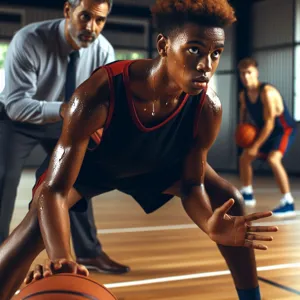
Mastering help defense is a critical aspect of becoming a stellar basketball defender. It’s not just about guarding your own man; it’s about being aware of the entire court and anticipating when your teammates might need assistance. Understanding when and how to assist can significantly impact the outcome of a game, transforming defensive plays into momentum-shifting moments.
First and foremost, communication is key. A solid defender must constantly talk to teammates, alerting them to potential threats and letting them know when to switch or call for help. Phrases like “I got your help!” or “Watch the backdoor!” can create a seamless defensive effort that confounds the opposing offense. Being vocal not only keeps the defense organized but also fosters a sense of trust among teammates.
Positioning is another essential element of effective help defense. A defender must maintain a balance between staying close to their assigned player and being ready to slide over when necessary. This often means being aware of the ball’s position, the offensive player’s strengths, and the potential for drives or cuts. A good rule of thumb is to stay in help-side position—meaning, if the ball is on one side of the court, you should be positioned on the opposite side, ready to close the gap when needed.
Timing is equally crucial. A defender must be able to read the game, recognizing when their assignment is being pressured or when the ball handler is poised to make a move. The key is to be decisive; if you wait too long, you may expose a weakness in the defense, allowing an easy score. Ideally, you want to step in and provide help just as your teammate is getting beat—creating a wall that disrupts the offensive flow.
Practice scenarios such as “two-on-one” drills can help develop the instincts needed for effective help defense. These drills allow defenders to practice their positioning, communication, and timing in a controlled environment, which can then translate into game situations.
Ultimately, mastering help defense is about being a team player. It requires a selfless mentality, where you prioritize the success of the team over individual accolades. By honing your ability to assist your teammates, you not only bolster your own defensive game but also pave the way for a more formidable and cohesive defensive unit. Remember, in basketball, defense wins games, and mastering help defense is a cornerstone of that philosophy.
6. The Importance of Communication on Defense
Communication is the backbone of an effective defensive strategy in basketball. On the court, players are constantly moving, and the dynamics of the game change in an instant. Without clear and consistent communication, defenders can easily become disoriented, leading to mismatches, open shots, or even uncontested drives to the basket.
Effective communication starts with vocal calls that alert teammates to potential threats. Terms like “help,” “screen,” or “switch” can make the difference between a successful defensive stand and a breakdown that allows the opposing team to capitalize. A defender who communicates well not only directs their teammates but also builds a sense of cohesion and trust within the defensive unit. This trust fosters a seamless flow where players instinctively know each other’s positioning and intentions.
Beyond vocal cues, body language plays a critical role in defense. A defender who maintains eye contact with their teammates and gestures appropriately can convey messages without saying a word. Positioning is equally important; players should always be aware of where their teammates are, adjusting their stance to support their partners.
During games, the pressure can escalate quickly, but staying calm and collected while communicating effectively can keep the defense organized. Practicing defensive drills that emphasize communication—such as scrimmages with specific rules around calling out plays—can help instill these habits in players.
Ultimately, when defenders prioritize communication, they create a formidable wall that is difficult for opponents to penetrate. The synergy that develops through constant dialogue on the court not only enhances individual performance but also transforms the entire team into a defensive powerhouse. In basketball, as in life, it’s the connections we forge that lead to success, and on the defensive end, those connections can turn the tide of a game.
7. Analyzing Opponents: Scouting and Anticipation
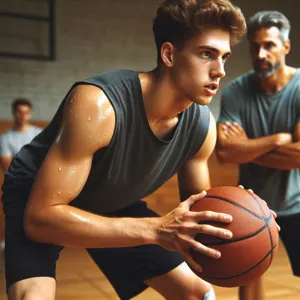
Analyzing opponents is a cornerstone of effective basketball defense, and it goes far beyond mere observation. To become a stellar defender, you must hone your ability to scout your adversaries and anticipate their moves. This process begins long before the game, with careful study of your opponents’ tendencies, strengths, and weaknesses.
Start by watching game film of your opponents, focusing on their go-to plays and favorite spots on the court. Pay attention to how they handle the ball under pressure, their shooting preferences, and how they respond when faced with different defensive styles. This analysis will provide invaluable insights into their playing habits. Are they right-handed or left-handed? Do they prefer to drive to their dominant hand, or are they more comfortable taking jump shots? Understanding these nuances will allow you to position yourself effectively and disrupt their rhythm.
In addition to film study, engage in conversations with your coaches and teammates who may have faced the opponent before. Their insights can provide unique perspectives on specific players’ tendencies that might not be apparent in video analysis alone.
During the game, let your anticipation guide your defensive efforts. Rather than merely reacting to the ball, stay one step ahead by reading the offensive player’s body language and movements. Watch their eyes and foot placement; these cues can often hint at their next move. For instance, if a player has their eyes fixed on the basket, they may be preparing to shoot or drive. If they’re looking to pass, they might be preparing to make a quick move to create space.
Remember, effective defense is as much about mental acuity as it is about physical skill. By combining thorough scouting with keen anticipation, you can become a formidable presence on the court, ready to thwart your opponent’s every move and create opportunities for your team. In the game of basketball, knowledge truly is power, and mastering this strategy will elevate your defensive game to stellar heights.
8. Developing Quick Hands: Tips for Steals and Blocks
Developing quick hands is crucial for any aspiring basketball defender looking to elevate their game. Quick hands not only enhance your ability to steal the ball but also significantly improve your chances of executing effective blocks. Mastering this skill requires a combination of technique, reaction time, and relentless practice. Here are some tips to help you develop those lightning-fast hands.
First and foremost, focus on your hand-eye coordination. Simple drills, such as tossing a tennis ball against a wall and catching it, can sharpen your reflexes and improve your overall dexterity. Incorporate exercises that challenge your coordination, like dribbling with both hands or using reaction balls that bounce unpredictably. These activities will help you become more agile and responsive on the court.
Next, practice your defensive stance. A low, balanced position allows you to react more swiftly to your opponent’s movements. As you defend, keep your hands active — they should be constantly moving to disrupt passing lanes and create opportunities for steals. Make it a habit to swipe at the ball when your opponent drives in for a layup or attempts a shot. The key is to time your movements precisely; going for a steal too soon or too late can lead to fouls or missed opportunities.
Additionally, study the game. Watch film of exceptional defenders and analyze their techniques. Notice how they position their hands and anticipate their opponents’ moves. Emulating these techniques in drills can help you internalize the movements needed for effective steals and blocks.
Lastly, don’t underestimate the power of strength training. Developing wrist and forearm strength can significantly enhance your grip and control, making it easier to snatch the ball away from an unsuspecting player. Incorporate exercises like wrist curls and hand grippers into your routine to build the necessary muscle.
By focusing on these aspects, you can cultivate quick hands that set you apart as a defensive powerhouse on the basketball court. Remember, every great defender started with a commitment to relentless improvement — so lace up those sneakers and get to work!
9. Conditioning for Defensive Excellence
Conditioning is the cornerstone of defensive excellence in basketball. While many players focus on offensive skills, the best defenders understand that their effectiveness hinges on their physical readiness. A well-conditioned athlete can maintain a high level of intensity throughout the game, enabling them to stay glued to their opponents, contest shots, and disrupt offensive plays without losing steam.
To achieve this, players should engage in a comprehensive conditioning program that emphasizes both cardiovascular fitness and muscular endurance. Incorporating high-intensity interval training (HIIT) can simulate the up-and-down motion of a basketball game, helping players develop the stamina needed to keep pace with fast breaks and quick transitions. Sprinting drills can also improve speed and agility, ensuring defenders can react swiftly to offensive movements.
Moreover, a strong core is fundamental for effective defensive positioning. Exercises like planks, medicine ball twists, and rotational movements enhance stability and balance, which are essential for staying low and maintaining a solid defensive stance. Flexibility training, including dynamic stretching and yoga, can further enhance mobility, allowing defenders to move fluidly and respond to their opponent’s actions.
Lastly, integrating sport-specific drills that mimic game situations can be invaluable. For instance, shadowing a partner while they dribble or practicing close-out techniques will help reinforce the skills necessary to excel defensively. By prioritizing conditioning in their training regimen, players will not only elevate their defensive performance but also contribute significantly to their team’s overall success. In basketball, as in life, being prepared is half the battle, and conditioning is the key that unlocks a defender’s potential on the court.
10. Defensive Rebounding: Securing Possessions
Defensive rebounding is a crucial yet often overlooked aspect of basketball defense that can significantly impact the outcome of a game. The moment a shot goes up, the defense’s job doesn’t end; in fact, it transitions into a new phase where securing the rebound can dictate possession and momentum. A solid defensive rebounder not only halts the opposing team’s scoring opportunity but also creates a chance for their own team to push the ball down the court and score.
To excel in this area, players must hone their awareness and positioning. Anticipating where the ball will land is key—this often means reading the shooter’s angle and trajectory and positioning yourself accordingly. Getting a body on your opponent as the shot is taken can prevent them from easily accessing the rebound, giving you a better chance to secure the ball.
Height and athleticism play a role, but technique is equally important. Mastering the art of boxing out can transform a good defender into a great one. This involves using your body to shield the opposing player from the basket, allowing you to establish position and leverage when the ball comes down.
Once you’ve secured the rebound, it’s essential to make a quick decision. Look for an outlet pass to start a fast break, or settle into a more organized offensive set. Remember, every defensive rebound not only stifles the opponent’s offense but also energizes your team and can shift the game’s momentum in your favor. By prioritizing defensive rebounding, you not only contribute to your team’s defensive efforts but also play a vital role in facilitating scoring opportunities. Emphasizing this key element in your game will help you become a stellar basketball defender who is invaluable on the court.
11. The Art of Closeouts: Challenging Shots Effectively
The art of closeouts is a critical skill that can define the success of a basketball defender. It’s not just about rushing at an opponent with reckless abandon; rather, it’s a delicate balance of aggression and control that can make all the difference in challenging shots effectively. When executed properly, a closeout can disrupt an offensive player’s rhythm, forcing them to alter their shot or make a rushed decision.
To master the closeout, defenders should start by anticipating the shooter’s movements. As the offensive player catches the ball, a defender must close the distance quickly, but with purpose. This means sprinting hard initially, but then breaking down into a controlled stance as they approach, ensuring they are low and balanced. The key is to arrive on the shooter’s personal space, making them feel pressured without overcommitting and allowing them to drive past.
As you approach, keep your hands up and active. This not only makes you look bigger to the shooter but can also block their line of sight. It’s essential to be aware of the shooter’s body language—watch for signs that they might pull the trigger on a shot or put the ball on the floor to drive. If they show signs of shooting, a quick leap can be effective, but timing is crucial; jump too early, and you risk giving them an open look or allowing them to blow by you.
Moreover, a good closeout also includes footwork. Use a “choppy” step technique to adjust quickly to the shooter’s movements. This helps in maintaining balance and being prepared for a possible drive or shot. Remember, the goal is to challenge the shot without fouling, so maintaining discipline is key.
Lastly, practice is vital. Regularly incorporate closeout drills into your training sessions. Whether it’s simulated game scenarios or simple partner drills, repetition will help engrain the technique until it becomes second nature. By honing the art of closeouts, you will not only become a more formidable defender but also instill a sense of urgency and pressure that can shift the momentum of a game. In basketball, where every shot counts, mastering this skill could very well be the difference between victory and defeat.
12. Learning from the Pros: Studying Great Defenders
When it comes to mastering the art of defense in basketball, one of the most effective strategies is to learn from the pros. Great defenders have a wealth of experience and techniques that can provide invaluable insights into becoming a stellar defender yourself. By studying their movements, strategies, and mental approaches, you can elevate your defensive game to new heights.
Start by analyzing the playing styles of renowned defensive stalwarts such as Gary Payton, Scottie Pippen, or more recent players like Kawhi Leonard and Marcus Smart. Watch game footage to observe their footwork, positioning, and reaction times. Take notes on how they anticipate offensive plays and how they use their bodies to disrupt dribblers and shooters. Notice how they maintain a low center of gravity, enabling them to explode in any direction while keeping their balance.
In addition to video analysis, consider breaking down specific defensive scenarios they’ve encountered. How do they handle pick-and-roll situations? What adjustments do they make when guarding different positions? By dissecting these moments, you can internalize these lessons and apply them during your own practices and games.
Furthermore, don’t limit yourself to just the professionals in the NBA. Explore international leagues, college basketball, or even local games, where you might find hidden gems of defensive prowess. Engaging with a variety of playing styles will broaden your understanding of defense and expose you to techniques that may work better for your own game.
Lastly, consider reaching out to coaches or trainers who emphasize defensive skills. They can provide tailored drills and feedback based on your observations of the pros, helping you to refine your technique and approach.
By immersing yourself in the world of elite defenders, you’ll not only gain a deeper appreciation for the nuances of defensive basketball but also develop the skills necessary to make a significant impact on the court. Remember, great defense is often about intelligence, anticipation, and relentless effort—qualities you can cultivate by learning from the best.
13. Common Defensive Mistakes and How to Avoid Them
When it comes to basketball defense, even the most seasoned players can fall into common traps that undermine their effectiveness on the court. Understanding these mistakes—and how to avoid them—is crucial for anyone looking to elevate their defensive game. Here are some of the most frequent defensive errors and strategies to steer clear of them.
**1. Overcommitting on Fakes:** One of the biggest blunders defenders make is biting on offensive players’ fakes. Whether it’s a jab step or a head fake, overcommitting can leave you out of position and create an easy scoring opportunity for the opponent. To combat this, maintain a balanced stance and keep your weight slightly back, allowing for quick lateral movements without losing your footing.
**2. Poor Positioning:** Defensive positioning is key to effective guarding. Many players find themselves too close or too far from their assignments, which can create gaps for shooters or allow drives to the basket. To prevent this, focus on staying in a low, athletic stance while keeping your body between your opponent and the basket. Always be aware of your spacing relative to both the ball and your man.
**3. Neglecting Off-Ball Awareness:** It’s easy to get fixated on the player you’re guarding, but neglecting off-ball awareness can lead to easy backdoor cuts or open shots. Always keep one eye on the ball while being conscious of your assignment’s movements. Developing a habit of constant head checks will help you anticipate plays and react quickly to threats.
**4. Failing to Communicate:** Effective communication is essential for a strong defensive unit. Players often overlook the importance of calling out screens, switches, or any other defensive adjustments. Develop a system of verbal cues with your teammates; this not only fosters cohesion but also ensures that everyone is on the same page during high-pressure situations.
**5. Relying Solely on Physicality:** While being physical can be an asset in defense, over-relying on it can lead to fouls and free throw opportunities for the opponent. Work on honing your footwork and technique instead. This includes using your body to create a barrier without excessive contact and learning to anticipate your opponent’s moves rather than simply reacting.
By recognizing these common defensive mistakes and actively working to improve your techniques, you can position yourself as a formidable defender on the court. Remember, a great defense is not just about individual skills; it’s about teamwork, awareness, and a relentless commitment to improvement. With practice and dedication, you can become the defensive stalwart that every team needs.
14. Drills to Enhance Your Defensive Skills
To elevate your defensive game, incorporating targeted drills into your practice routine is essential. These exercises not only sharpen your skills but also instill the mindset needed to become a formidable defender on the court. Here are some effective drills that can help enhance your defensive prowess:
1. **Closeout Drill**: This drill simulates the critical moment of closing out on a shooter. Start in a defensive stance, and as your coach or a teammate simulates a pass, sprint towards the shooter. Practice breaking down your speed, keeping your hands up, and staying low to contest the shot without fouling. This drill hones your ability to respond quickly and maintain balance while defending.
2. **1-on-1 Shadowing**: Pair up with a teammate and take turns being the offensive player and the defender. As the offensive player tries to maneuver and create space, focus on staying in a low stance, maintaining your defensive position, and anticipating their movements. This drill helps improve footwork, agility, and your ability to read the offensive player’s intentions.
3. **Defensive Slide Drill**: Set up cones in a zigzag pattern and practice sliding from cone to cone while maintaining a defensive stance. Ensure that you keep your feet low, your weight balanced, and your hands active. This drill enhances lateral quickness and stamina, both of which are crucial for effective on-ball and off-ball defense.
4. **Help and Recover Drill**: This drill emphasizes team defense and communication. Start with a 2-on-2 or 3-on-3 setup. When the offensive player drives, the defender must provide help while keeping an eye on their assigned player. After the help is given, practice quickly recovering back to your original assignment. This drill teaches you to react instinctively and work cohesively as a unit.
5. **Box Out Drill**: To become a complete defender, mastering rebounding is crucial. Work on your box-out technique by pairing up with a teammate. As a shot goes up, practice positioning your body between the offensive player and the basket, using your lower body strength to establish leverage. This is essential for limiting second-chance opportunities for the opposition.
By consistently integrating these drills into your training regimen, you’ll not only enhance your skill set but also develop a defensive mindset that can make a significant impact during games. Remember, defense isn’t just about physical ability; it’s about heart, hustle, and the willingness to put in the work to outsmart your opponent. Embrace these drills, and watch as your defensive game transforms, making you an invaluable asset to your team.
15. Conclusion: Embracing the Defense Wins Games Philosophy
In the fast-paced world of basketball, where high scores and flashy plays often steal the spotlight, the importance of defense can sometimes be overshadowed. However, as we’ve explored in this post, the philosophy that “defense wins games” is not just a catchy phrase; it’s a foundational principle that can elevate your game and that of your team. Each defensive strategy, from mastering on-ball techniques to understanding the intricacies of help defense, plays a critical role in creating a cohesive unit that can disrupt opposing offenses and seize control of the game.
Embracing this mindset requires dedication, discipline, and an unwavering commitment to improving every facet of your defensive game. Whether you’re a player striving to enhance your skills or a coach looking to instill a robust defensive culture within your team, remember that great defenders are made through hard work and a willingness to learn. By focusing on fundamentals, maintaining relentless effort, and fostering communication on the court, you can transform your defensive presence from a mere afterthought into a game-changing force.
Ultimately, defense is about more than just stopping the opponent; it’s about setting the tone for your team, inspiring confidence, and creating opportunities for offense. As you step onto the court, carry with you the knowledge that every block, steal, and contested shot contributes not only to the scoreboard but also to the heart and soul of the game. So, embrace the defense wins games philosophy—because with every solid defensive play, you’re not just defending your basket; you’re building the foundation for victory.
In conclusion, mastering the art of defense is crucial for any basketball player looking to elevate their game and contribute significantly to their team’s success. By focusing on the essential keys we’ve outlined—such as maintaining a low defensive stance, anticipating your opponent’s moves, and communicating effectively with teammates—you can transform yourself into a stellar defender. Remember, great defense not only stops the opposing team from scoring but also creates opportunities for your own team to thrive. As you put these strategies into practice, you’ll not only enhance your skills but also inspire those around you to embrace the importance of defense on the court. Get out there, work hard, and let your defensive prowess shine!




